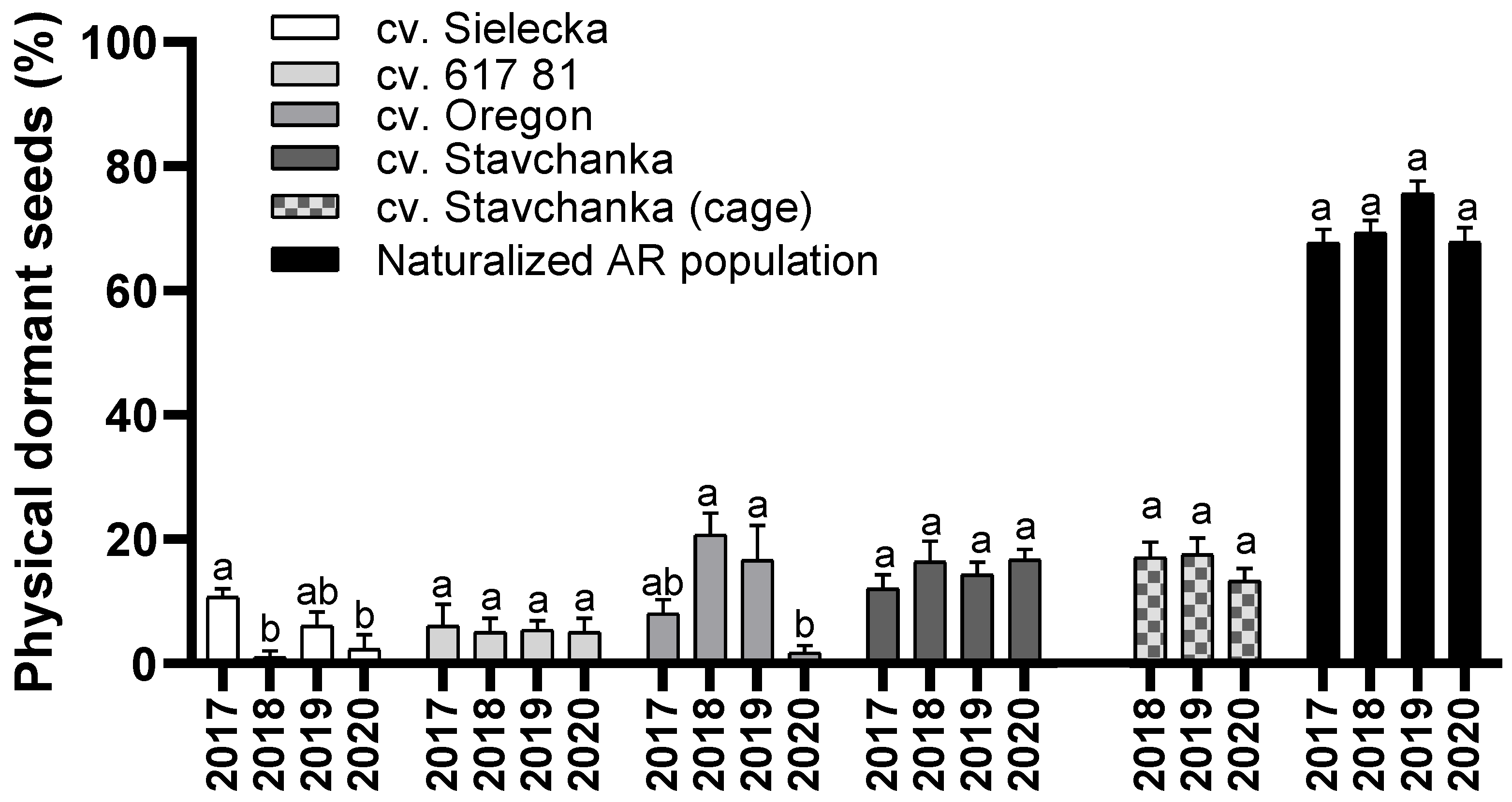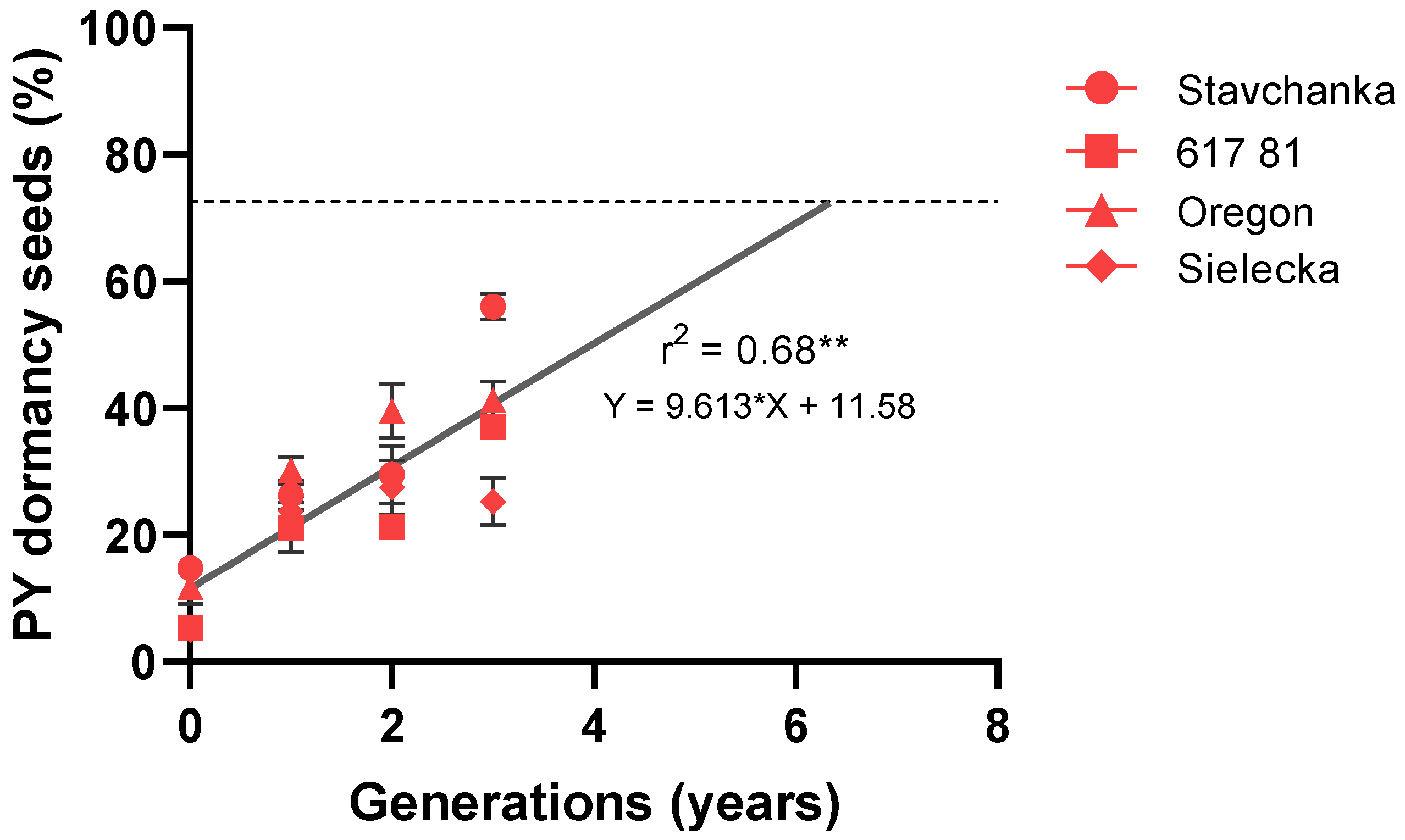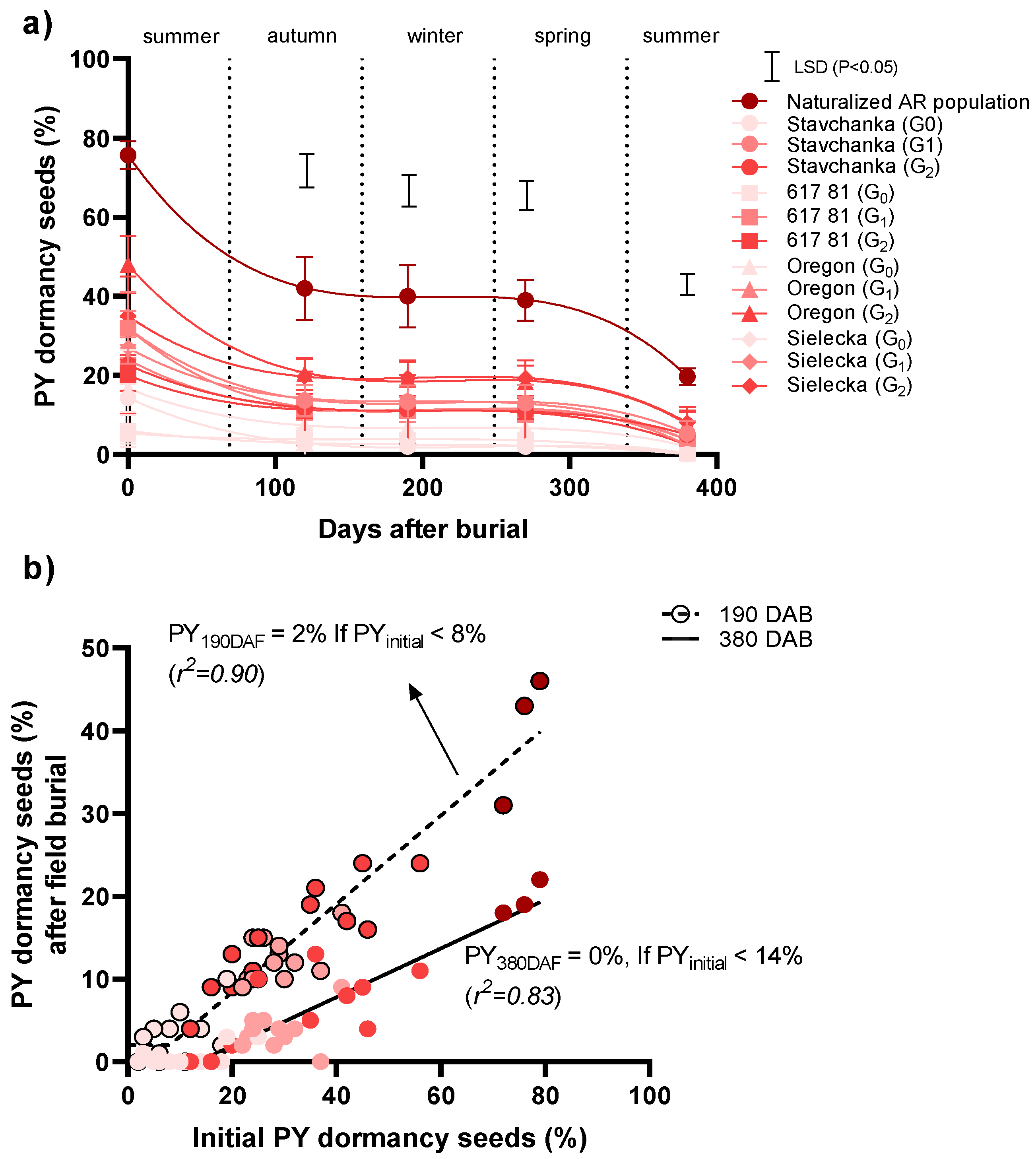Spontaneous Gene Flow between Cultivated and Naturalized Vicia villosa Roth Populations Increases the Physical Dormancy Seed in a Semiarid Agroecosystem
Abstract
1. Introduction
2. Materials and Methods
2.1. Seed Collection Sources
2.2. Seed Production for Comparative PY Experiments
2.3. PY-Dormancy Testing
2.4. Seed Burial Experiments
2.5. Statistical Analysis
3. Results
4. Discussion
5. Conclusions
Supplementary Materials
Author Contributions
Funding
Institutional Review Board Statement
Informed Consent Statement
Data Availability Statement
Acknowledgments
Conflicts of Interest
References
- van de Wouw, M.; Enneking, D.; Robertson, L.D.; Maxted, N. Vetches Vicia L. In Plant Genetic Resources of Legumes in the Mediterranean; Maxted, N., Bennett, S.J., Eds.; Kluwer: Dordrecht, The Netherlands, 2001; pp. 132–157. [Google Scholar]
- Bryant, J.A.; Hughes, S.G. Vicia, in Wild Crop Relatives: Genomic and Breeding Resources Legume Crops and Forage; Kole, C., Ed.; Springer: Berlin/Heidelberg, Germany, 2011; pp. 273–289. [Google Scholar]
- Francis, C.M.; Enneking, D.; Abd El Moneim, A. When and where will vetches have an impact as grain legumes? In Linking Research and Marketing Opportunities for Pulses in the 21st Century, Proceedings of the Third International Food Legume Research Conference, Adelaide, Australia, 22–26 September 1997; Knight, R., Ed.; Kluwer Academic Publishers: Dordrecht, The Netherlands, 1999; Volume 34, pp. 668–671. [Google Scholar]
- Renzi, J.P.; Cantamutto, M.A. Vicias: Bases agronómicas para el manejo en la Región Pampeana. In Vicias: Agronomic Bases for Management in the Pampas; Ediciones INTA: Buenos Aires, Argentina, 2013; p. 299. [Google Scholar]
- Aarssen, L.W.; Hall, I.V.; Jensen, K.I.N. The biology of Canadian weed: Vicia angustifolia L., V. cracca L., V. sativa L., V. tetrasperma (L.) Schreb. and V. villosa Roth. Can. J. Plant Sci. 1986, 66, 711–737. [Google Scholar] [CrossRef]
- Renzi, J.P.; Chantre, G.R.; Smýkal, P.; Presotto, A.D.; Zubiaga, L.; Garayalde, A.F.; Cantamutto, M.A. Diversity of naturalized hairy vetch (Vicia villosa roth) populations in Central Argentina as a source of potential adaptive traits for breeding. Front. Plant Sci. 2020, 11, 189. [Google Scholar] [CrossRef]
- Kissing Kucek, L.; Riday, H.; Rufener, B.P.; Burke, A.N.; Eagen, S.S.; Ehlke, N.; Krogman, S.; Mirsky, S.B.; Reberg-Horton, C.; Ryan, M.R.; et al. Pod dehiscence in hairy vetch (Vicia villosa roth). Front. Plant Sci. 2020, 11. [Google Scholar] [CrossRef] [PubMed]
- Kissing Kucek, L.; Azevedo, M.D.; Eagen, S.S.; Ehlke, N.J.; Hayes, R.J.; Mirsky, S.B.; Reberg-Horton, C.; Ryan, M.R.; Wayman, S.; Wiering, N.P.; et al. Seed dormancy in hairy vetch (Vicia villosa roth) is influenced by genotype and environment. Agronomy 2020, 10, 1804. [Google Scholar] [CrossRef]
- Renzi, J.P. Efecto de la Estructura de Cultivo y Grado de Madurez a Cosecha Sobre el Rendimiento y la Calidad de Semillas de Vicia sativa L. y V. villosa Roth., Bajo Riego. Master’s Thesis, Universidad Nacional del Sur, Buenos Aires, Argentina, 2009. [Google Scholar]
- Hyde, E.O.C. The function of the hilum in some Papilionaceae in relation to the ripening of the seed and the permeability of the testa. Ann. Bot. 1954, 11, 241–256. [Google Scholar] [CrossRef]
- Renzi, J.P.; Chantre, G.R.; Cantamutto, M.A. Development of a thermal-time model for combinational dormancy release of hairy vetch (Vicia villosa ssp. villosa). Crop Pasture Sci. 2014, 65, 470–478. [Google Scholar] [CrossRef]
- Renzi, J.P.; Chantre, G.R.; Cantamutto, M.A. Effect of water availability and seed source on physical dormancy break of Vicia villosa ssp. villosa. Seed Sci. Res. 2016, 26, 254–263. [Google Scholar] [CrossRef][Green Version]
- Wayman, S.; Kissing Kucek, L.; Mirsky, S.B.; Ackroyd, V.; Cordeau, S.; Ryan, M.R. Organic and conventional farmers differ in their perspectives on cover crop use and breeding. Renew Agric. Food Syst. 2016, 32, 376–385. [Google Scholar] [CrossRef]
- Hudson, A.R.; Ayre, D.J.; Ooi, M.K.J. Physical dormancy in a changing climate. Seed Sci. Res. 2015, 25, 66–81. [Google Scholar] [CrossRef]
- Lacerda, D.R.; Lemos Filho, J.P.; Goulart, M.F.; Ribeiro, R.A. Seed dormancy variation in natural populations of two tropical leguminous tree species: Senna multijuga (Caesalpinoideae) and Plathymenia reticulate (Mimosoideae). Seed Sci. Res. 2007, 14, 127–135. [Google Scholar] [CrossRef]
- Wilke, B.J.; Snapp, S.S. Winter cover crops for local ecosystems: Linking plant traits and ecosystem function. J. Sci. Food Agric. 2008, 88, 551–557. [Google Scholar] [CrossRef]
- Renzi, J.P.; Chantre, G.R.; González-Andújar, J.L.; Cantamutto, M.A. Development and validation of a simulation model for hairy vetch (Vicia villosa Roth) self-regeneration under different crop rotations. Field Crops Res. 2019, 235, 79–86. [Google Scholar] [CrossRef]
- Renzi, J.P.; Chantre, G.R.; Cantamutto, M.A. Self-regeneration of hairy vetch (Vicia villosa Roth) as affected by seedling density and soil tillage method in a semi-arid agroecosystem. Grass Forage Sci. 2017, 72, 535–544. [Google Scholar] [CrossRef]
- Loi, A.; Howieson, J.G.; Nutt, B.J.; Carr, S.J. A second generation of annual pasture legumes and their potential for inclusion in Mediterranean type farming systems. Aust. J. Exp. Agric. 2005, 45, 289–299. [Google Scholar] [CrossRef]
- Renzi, J.P.; Chantre, G.; Cantamutto, M.A. Vicia villosa ssp. villosa roth field emergence model in a semiarid agroecosystem. Grass Forage Sci. 2018, 73, 146–158. [Google Scholar] [CrossRef]
- Zhang, X.; Mosjidis, J.A. Breeding systems of several Vicia species. Crop Sci. 1995, 35, 1200–1202. [Google Scholar] [CrossRef]
- Petraityte, N.; Sliesaravicius, A.; Dastikaite, A. Potential reproduction and real seed productivity of Vicia villosa L. Biologija 2007, 53, 48–51. [Google Scholar]
- Al-Ghzawi, A.A.; Samarah, N.; Zaitoun, S.; Alqudah, A. Impact of bee pollinators on seed set and yield of V. villosa spp. dasycarpa (Leguminosae) grown under semiarid conditions. Ital. J. Anim. Sci. 2009, 8, 65–74. [Google Scholar] [CrossRef]
- Hunter, D.; Slate, J. Understanding genetic changes between generations. Proc. Natl. Acad. Sci. USA 2019, 116, 1834–1836. [Google Scholar] [CrossRef]
- International Seed Testing Association. International Rules for Seed Testing; ISTA: Zürich, Switzerland, 2019; p. 300. [Google Scholar] [CrossRef]
- Berger, J.D.; Shrestha, D.; Ludwig, C. Reproductive strategies in mediterranean legumes: Trade-offs between phenology, seed size and vigor within and between wild and domesticated lupinus species collected along aridity gradients. Front. Plant Sci. 2017, 8, 548. [Google Scholar] [CrossRef]
- Di Rienzo, J.A.; Casanoves, F.; Balzarini, M.G.; Gonzalez, L.; Tablada, M.; Robledo, C.W. InfoStat Version 2013; Grupo InfoStat, FCA, Universidad Nacional de Córdoba: Córdoba, Argentina, 2013. [Google Scholar]
- Dalling, J.W.; Davis, A.S.; Schutte, B.J.; Arnold, A.E. Seed survival in soil: Interacting effects of predation, dormancy and the soil microbial community. J. Ecol. 2011, 99, 89–95. [Google Scholar] [CrossRef]
- Fuerst, E.P.; Okubara, P.A.; Anderson, J.V.; Morris, C.F. Polyphenol oxidase as a biochemical seed defense mechanism. Front. Plant Sci. 2014, 5, 689. [Google Scholar] [CrossRef]
- Hendry, G.A.F.; Thompson, K.; Moss, C.J.; Edwards, E.; Thorpe, P.C. Seed persistence: A correlation between seed longevity in the soil and ortho-dihydroxyphenol concentration. Funct. Ecol. 1994, 8, 658–664. [Google Scholar] [CrossRef]
- Debeaujon, I.; Léon-Kloosterziel, K.M.; Koornneef, M. Influence of the testa on seed dormancy, germination, and longevity in Arabidopsis. Plant Physiol. 2000, 122, 403–414. [Google Scholar] [CrossRef] [PubMed]
- Lepiniec, L.; Debeaujon, I.; Routaboul, J.M.; Baudry, A.; Pourcel, L.; Nesi, N.; Caboche, M. Genetics and biochemistry of seed flavonoids. Annu. Rev. Plant Biol. 2006, 57, 405–430. [Google Scholar] [CrossRef]
- Smýkal, P.; Vernoud, V.; Blair, M.W.; Soukup, A.; Thompson, R.D. The role of the testa during development and in establishment of dormancy of the legume seed. Front. Plant Sci. 2014, 5, 351. [Google Scholar] [PubMed]
- Moïse, J.A.; Han, S.; Gudynaite-Savitch, L.; Johnson, D.A.; Miki, B.L.A. Seed coats: Structure, development, composition, and biotechnology. In Vitro Cell. Dev. Biol. Plant 2005, 41, 620–644. [Google Scholar] [CrossRef]
- Hradilová, I.; Duchoslav, M.; Brus, J.; Pechanec, V.; Hýbl, M.; Kopecký, P.; Smržová, L.; Štefelová, N.; Vaclávek, T.; Bariotakis, M.; et al. Variation in wild pea (Pisum sativum subsp. elatius) seed dormancy and its relationship to the environment and seed coat traits. PeerJ 2019, 7, e6263. [Google Scholar]
- Finch-Savage, W.E.; Footitt, S. Seed dormancy cycling and the regulation of dormancy mechanisms to time germination in variable field environments. J. Exp. Bot. 2017, 68, 843–856. [Google Scholar] [CrossRef]
- Fuller, D.Q.; Allaby, R. Seed Dispersal and crop domestication: Shattering, germination and seasonality in evolution under cultivation. In Fruit Development and Seed Dispersal; Ostergaard, L., Ed.; Blackwell: Oxford, UK, 2009; pp. 238–295. [Google Scholar]
- Kluyver, T.A.; Charles, M.; Jones, G.; Rees, M.; Osborne, L.P. Did greater burial depth increase the seed size of domesticated legumes? J. Exp. Bot. 2013, 64, 4101–4108. [Google Scholar] [CrossRef] [PubMed]
- Crockett, B.C.; Mirsky, S.; Curran, W.S. Hairy vetch seed bank persistence as influenced by mechanical scarification and soil depth. In Proceedings of the 66th Annual Meeting of the Northeastern Weed Science Society, Philadelphia, PA, USA, 3–6 January 2012; p. 20. Available online: www.newss.org/proceedings/proceedings_2012.pdf (accessed on 20 March 2021).
- Curran, W.S.; Wallace, J.M.; Mirsky, S.; Crockett, B.C. Effectiveness of herbicides for control of hairy vetch (Vicia villosa) in winter wheat. Weed Technol. 2015, 29, 509–518. [Google Scholar] [CrossRef]
- Jacobsen, K.L.; Gallagher, R.S.; Burnham, M.; Bradley, B.B.; Larson, Z.M.; Walker, C.W.; Watson, J.E. Mitigation of seed germination impediments in hairy vetch. Agron. J. 2010, 102, 1346–1351. [Google Scholar] [CrossRef]
- Mirsky, S.B.; Wallace, J.M.; Curran, W.S.; Crockett, B.C. Hairy vetch seedbank persistence and implications for cover crop management. Agron. J. 2015. [Google Scholar] [CrossRef]
- Mischler, R.; Duiker, S.W.; Curran, W.S.; Wilson, D. Hairy vetch management for no-till organic corn production. Agron. J. 2010, 102, 355–362. [Google Scholar] [CrossRef]
- Pittman, K.B.; Barney, J.N.; Cahoon, C.W.; Flessner, M.L. Influence of hairy vetch seed germination and maturation on weediness in subsequent crops. Weed Res. 2019, 59, 427–436. [Google Scholar] [CrossRef]
- Renzi, J.; Cantamutto, M. Dormancia y germinación en semillas de Vicia villosa Roth. Anál. Semillas 2009, 3, 84–89. [Google Scholar]
- Venable, D.L.; Brown, J.S. The selective interactions of dispersal, dormancy, and seed size as adaptations for reducing risk in variable environments. Am. Nat. 1988, 131, 360–384. [Google Scholar] [CrossRef]
- Rubio de Casas, R.; Willis, C.G.; Pearse, W.D.; Baskin, C.C.; Baskin, J.M.; Cavender-Bares, J. Global biogeography of seed dormancy is determined by seasonality and seed size: A case study in the legumes. New Phytol. 2017, 214, 1527–1536. [Google Scholar] [CrossRef]
- Norman, H.C.; Cocks, P.C.; Galwey, N.W. Hardseededness in annual clovers: Variation between populations from wet and dry environments. Aust. J. Agric. Res. 2002, 53, 821–829. [Google Scholar] [CrossRef]
- Thompson, J.D. Plant Evolution in the Mediterranean; Oxford University Press: Oxford, UK, 2005. [Google Scholar] [CrossRef]
- Ellstrand, N.C. Is gene flow the most important evolutionary force in plants? Am. J. Bot. 2014, 101, 737–753. [Google Scholar] [CrossRef]
- Smýkal, P.; Nelson, M.N.; Berger, J.D.; Von Wettberg, E.J.B. The impact of genetic changes during crop domestication. Agronomy 2018, 8, 119. [Google Scholar] [CrossRef]
- Magnussen, L.S.; Hauser, T.P. Hybrids between cultivated and wild carrots in natural populations in Denmark. Heredity 2007, 99, 185–192. [Google Scholar] [CrossRef]
- Maul, J.; Mirsky, S.; Emche, S.; Devine, T. Evaluating a germplasm collection of the cover crop hairy vetch for use in sustainable farming systems. Crop Sci. 2011, 51, 2615–2625. [Google Scholar] [CrossRef]




| Country of Origin | Accession/Locality | Number * | PY Level ** |
|---|---|---|---|
| Poland | Sielecka | 05L1700015 | <12% |
| Turkey | 617 81 | 05L1700046 | <12% |
| Germany | Oregon | 05L1700066 | <30% |
| Russia | Stavchanka | 05L1700061 | <23% |
| Argentina | Ascasubi | ------- | >72% |
| Generations # | European Cultivars | Naturalized AR Population | LSD (p < 0.05) | |||
|---|---|---|---|---|---|---|
| 617 81 | Sielecka | Oregon | Stavchanka | |||
| Physical Dormant Seeds (%) | ||||||
| 2017 | ||||||
| G0 | 5.3 ± 6.0 | 10.6 ± 2.3 | 8.1 ± 4.0 | 12.0 ± 3.9 | 67.8 ± 3.8 | 8.4 ** |
| 2018 | ||||||
| G0 | 5.2 ± 4.0 | 1.0 ± 1.7 | 20.6 ± 3.0 | 16.4 ± 5.8 | 69.3 ± 3.5 | 8.6 ** |
| G1 | 25.0 ± 3.0 | 29.3 ± 3.2 | 38.0 ± 1.7 | 22.4 ± 3.6 | 66.1 ± 2.0 | 5.9 ** |
| LSD (p < 0.05) | 0.14 ** | 0.18 ** | 0.12 * | NS | NS | |
| 2019 | ||||||
| G0 | 5.3 ± 2.0 | 6.0 ± 4.1 | 16.8 ± 9.7 | 14.4 ± 3.5 | 75.7 ± 3.6 | 10.8 ** |
| G1 | 32.0 ± 4.4 | 27.1 ± 2.6 | 24.0 ± 2.0 | 32.0 ± 9.1 | 71.2 ± 13.2 | 13.9 ** |
| G2 | 20.0 ± 4.1 | 35.2 ± 10.0 | 48.0 ± 7.2 | 22.7 ± 12.2 | 70.3 ± 8.1 | 18.1 ** |
| LSD (p < 0.05) | 7.4 ** | 12.8 ** | 14.4 ** | NS | NS | |
| 2020 | ||||||
| G0 | 4.3 ± 4.4 | 2.3 ± 4.0 | 1.6 ± 2.1 | 16.7 ± 2.9 | 67.8 ± 4.0 | 7.3 ** |
| G1 | 6.7 ± 1.5 | 15.0 ± 2.0 | 28.7 ± 1.1 | 25.0 ± 5.0 | 72.2 ± 4.3 | 6.2 ** |
| G2 | 22.6 ± 4.5 | 20.0 ± 2.6 | 31.0 ± 1.7 | 36.4 ± 5.8 | 76.4 ± 14.7 | 14.7 ** |
| G3 | 37.0 ± 0.8 | 25.3 ± 6.6 | 41.3 ± 5.1 | 56.1 ± 3.6 | 75.7 ± 9.1 | 11.6 ** |
| LSD (p < 0.05) | 5.9 ** | 7.8 ** | 5.6 ** | 8.4 ** | NS | |
| Generations × Genotype | ** | |||||
Publisher’s Note: MDPI stays neutral with regard to jurisdictional claims in published maps and institutional affiliations. |
© 2021 by the authors. Licensee MDPI, Basel, Switzerland. This article is an open access article distributed under the terms and conditions of the Creative Commons Attribution (CC BY) license (https://creativecommons.org/licenses/by/4.0/).
Share and Cite
Renzi, J.P.; Reinoso, O.; Quintana, M.; Smýkal, P. Spontaneous Gene Flow between Cultivated and Naturalized Vicia villosa Roth Populations Increases the Physical Dormancy Seed in a Semiarid Agroecosystem. Agronomy 2021, 11, 955. https://doi.org/10.3390/agronomy11050955
Renzi JP, Reinoso O, Quintana M, Smýkal P. Spontaneous Gene Flow between Cultivated and Naturalized Vicia villosa Roth Populations Increases the Physical Dormancy Seed in a Semiarid Agroecosystem. Agronomy. 2021; 11(5):955. https://doi.org/10.3390/agronomy11050955
Chicago/Turabian StyleRenzi, Juan Pablo, Omar Reinoso, Matías Quintana, and Petr Smýkal. 2021. "Spontaneous Gene Flow between Cultivated and Naturalized Vicia villosa Roth Populations Increases the Physical Dormancy Seed in a Semiarid Agroecosystem" Agronomy 11, no. 5: 955. https://doi.org/10.3390/agronomy11050955
APA StyleRenzi, J. P., Reinoso, O., Quintana, M., & Smýkal, P. (2021). Spontaneous Gene Flow between Cultivated and Naturalized Vicia villosa Roth Populations Increases the Physical Dormancy Seed in a Semiarid Agroecosystem. Agronomy, 11(5), 955. https://doi.org/10.3390/agronomy11050955








